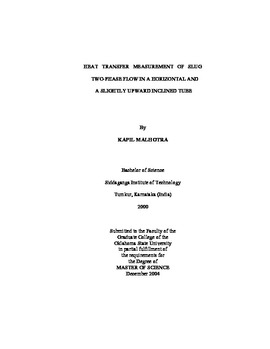| dc.contributor.advisor | Ghajar, Afshin A. | |
| dc.contributor.author | Malhotra, Kapil | |
| dc.date.accessioned | 2014-04-17T19:53:07Z | |
| dc.date.available | 2014-04-17T19:53:07Z | |
| dc.date.issued | 2004-12-01 | |
| dc.identifier.uri | https://hdl.handle.net/11244/9987 | |
| dc.description.abstract | Two-phase slug flow (air-water) is characterized by moderate gas and liquid flow rates. This type of flow occurs in many industrial applications such as condensers, evaporators and pipe lines. In this study two-phase slug flow, heat transfer analysis has been carried out at horizontal, 20, 50 and 70 tube inclinations. Systematically controlled heat transfer runs have been made so that a better understanding of heat transfer can be obtained. This study has been fortified by using flow visualization videos and pictures to explain the intricacies of the heat transfer. The study has been done on a pipe with length to diameter ration (L/D) of 100 with uniform heat flux around the periphery ranging from 2734 to 10787 W/m2, liquid mass flow rate from 6.21 to 42.55 kg/min and gas mass flow rate from 0.0148 to 0.159 kg/min. Data at various inclinations have been compared systematically and a detailed discussion of the heat transfer trend is discussed. In the end, a unified slug flow heat transfer correlation has been developed which predicts the heat transfer for both horizontal and the inclined tube positions. The results confirmed that the heat transfer in slug flow is dominated by the superficial liquid velocity. It was observed from the systematically controlled individual superficial liquid Reynolds number runs, that heat transfer of slug flow has its own specific trend. This trend remained the same for various tube inclinations. The heat transfer coefficient increased with the tube inclination. However, no significant increase in heat transfer was observed after 50 tube inclination. Flow visualization pictures confirmed that at some specific water and gas mass flow rates, the formation of excess bubbles hinder the heat transfer in the flow. From the heat transfer data gathered in this study, a general correlation for predicting heat transfer was developed. This unified correlation predicts 92% of both the horizontal and inclined slug flow data points (141 data points) used in this study within �15% deviation range. | |
| dc.format | application/pdf | |
| dc.language | en_US | |
| dc.publisher | Oklahoma State University | |
| dc.rights | Copyright is held by the author who has granted the Oklahoma State University Library the non-exclusive right to share this material in its institutional repository. Contact Digital Library Services at lib-dls@okstate.edu or 405-744-9161 for the permission policy on the use, reproduction or distribution of this material. | |
| dc.title | Heat Transfer Measurement of Slug Two Phase Flow in a Horizontal and a Slightly Upward Inclined Tube | |
| dc.type | text | |
| dc.contributor.committeeMember | Chambers, Frank W. | |
| dc.contributor.committeeMember | Moretti, P.M. | |
| osu.filename | Malhotra_okstate_0664M_1113.pdf | |
| osu.college | Engineering, Architecture, and Technology | |
| osu.accesstype | Open Access | |
| dc.description.department | Mechanical & Aerospace Engineering | |
| dc.type.genre | Thesis | |
